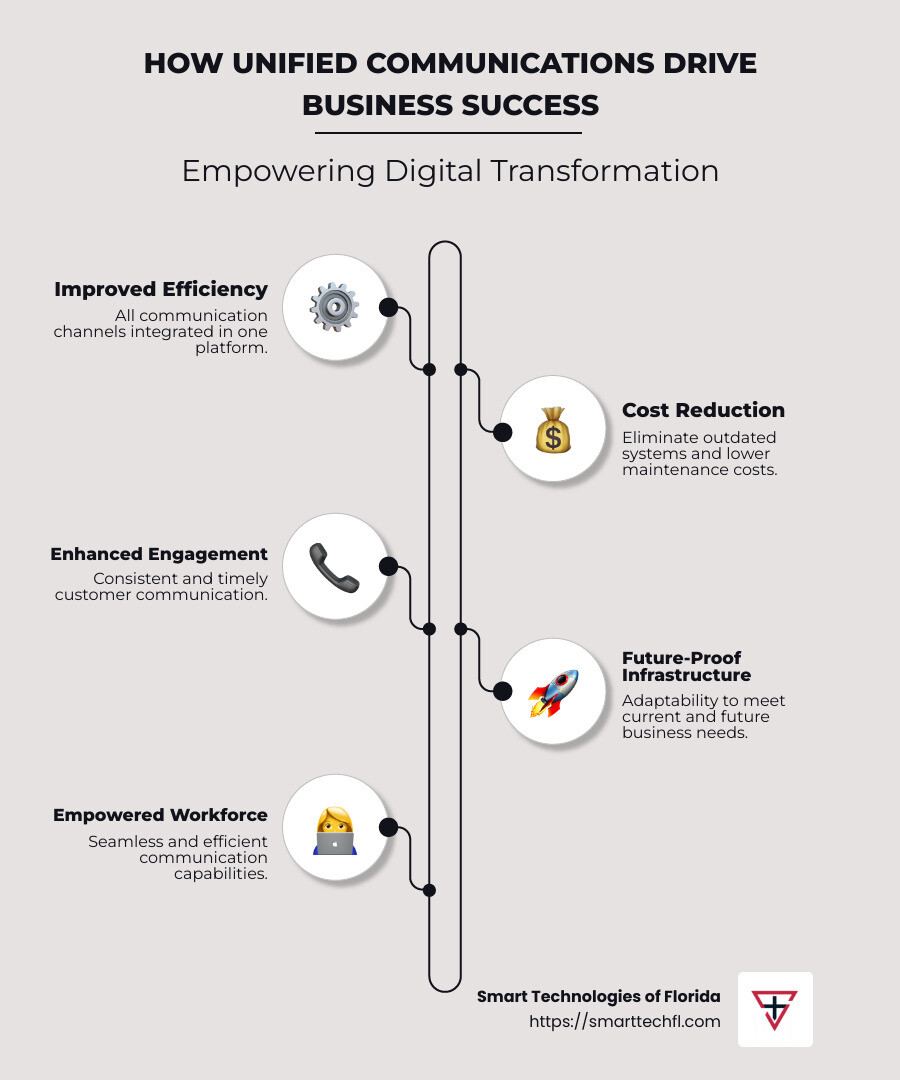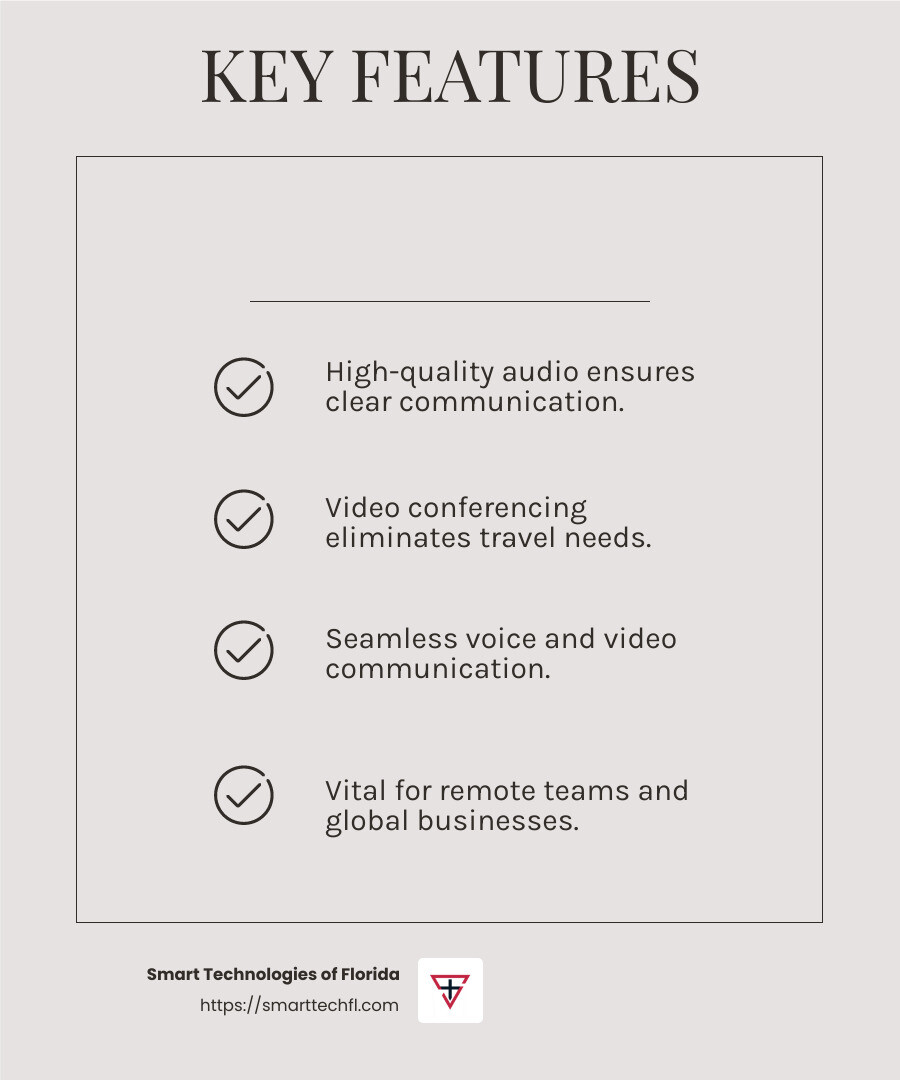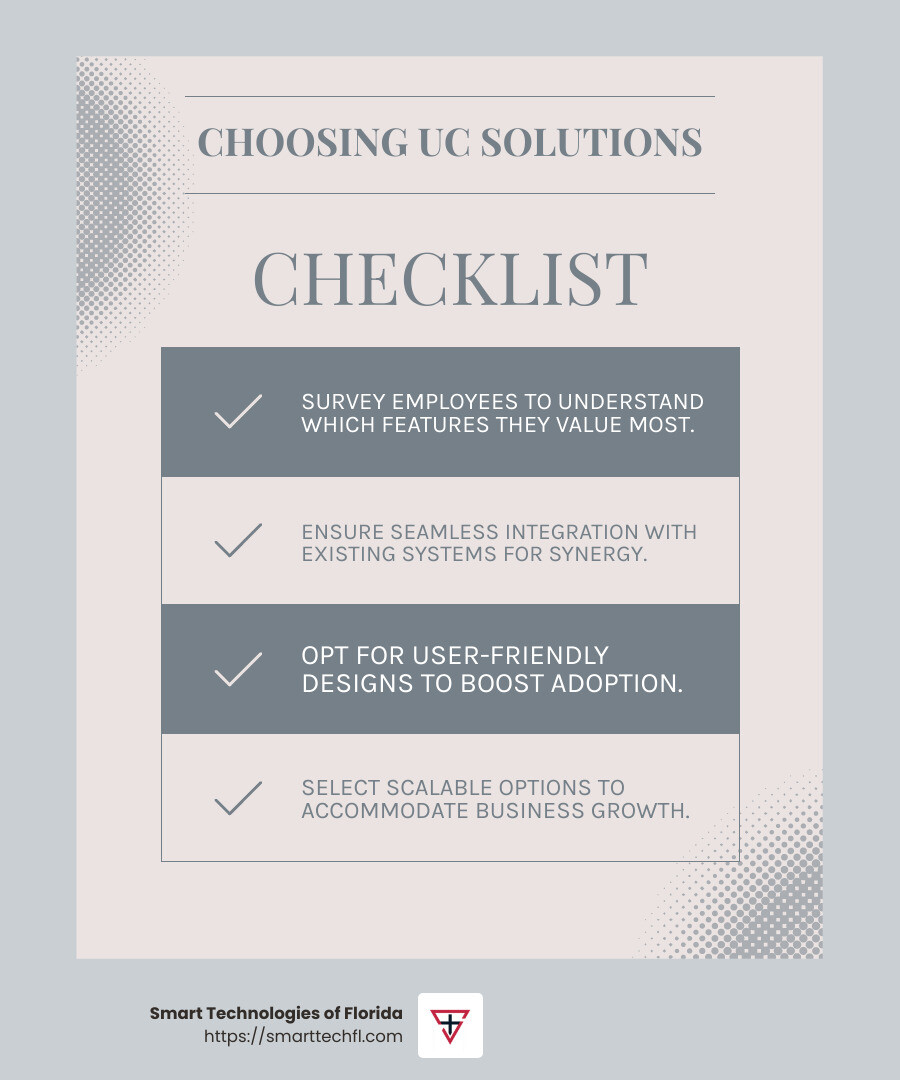Unified Communications Explained: Transforming Business Interactions
Unified communications solutions are changing the way businesses operate today. These digital tools combine various communication methods—such as video conferencing, voice calls, messaging, and file sharing—into a single, integrated platform. This change helps companies streamline their operations and improves the user experience, making it easier to connect with clients and colleagues worldwide.
In the world of retail, businesses that accept unified communications solutions stand to gain significant advantages:
- Improved Operational Efficiency: With everything in one place, your team spends less time switching between different apps and more time focusing on what matters.
- Cost Reduction: Say goodbye to outdated and costly communication infrastructures. Unified solutions cut down on maintenance and overhead costs.
- Improved Customer Engagement: Ensure consistent and timely communication with customers, improving satisfaction and retention rates.
Digital solutions are no longer just nice-to-have; they’re essential for any business looking to stay competitive. By strategically integrating these technologies, businesses can lead the way in their industries, meeting both current demands and future growth opportunities.
Here’s the road ahead for businesses ready for a strategic change: Develop a custom communication infrastructure that doesn’t just support, but empowers your workforce to communicate seamlessly and efficiently.

What are Unified Communications Solutions?
Unified communications solutions are all about bringing various communication tools under one roof. Imagine having voice calls, video conferences, instant messaging, and file sharing all integrated into a single platform. This setup isn’t just convenient—it’s transformative for businesses.
Integrated Technology
At the core of unified communications solutions is integrated technology. This means different communication channels work together seamlessly. You can start a conversation with a chat, switch to a voice call, and then move to a video conference without juggling multiple apps. The ease of switching between these modes improves user productivity and reduces friction in communication.
Communication Channels
Unified communications solutions support a wide array of communication channels. This includes:
- Voice Calls: Traditional phone calls are now improved with features like call forwarding and voicemail.
- Video Conferencing: High-quality video calls that can host multiple participants, perfect for virtual meetings.
- Instant Messaging: Quick text-based communication for fast and efficient exchanges.
- Content Sharing: Share files and documents in real-time, ensuring everyone has the latest information.
These channels are not just add-ons; they are essential components that work together to create a cohesive communication experience.
Enterprise Communications
For businesses, unified communications solutions are a game-changer in enterprise communications. They allow companies to maintain consistent and effective communication across all levels of the organization. Whether it’s a small team or a large enterprise, these solutions ensure that everyone stays connected and informed.
Moreover, unified communications platforms often integrate with other business applications like project management tools. This integration centralizes information and resources, making workflows more efficient and reducing the time spent on administrative tasks.
Unified communications solutions are not just about technology—they’re about changing how businesses communicate. They provide a streamlined approach that supports both real-time and asynchronous communications, making them a vital part of modern enterprise operations.
Key Features of Unified Communications Solutions
Unified communications solutions come packed with features that transform business interactions. These features streamline communication, boost productivity, and improve collaboration. Let’s explore the key components that make these solutions indispensable.
Voice and Video
Voice and video capabilities are the backbone of unified communications. They allow for seamless communication, whether you’re making a quick call or hosting a large video conference.
- High-Quality Audio and Video: Ensures clear communication, crucial for effective meetings. Users can rely on robust voice services, even in areas with weak internet connections.
- Video Conferencing: Enables face-to-face meetings without the need for travel. This is vital for remote teams and global businesses.

Messaging
Messaging is a critical feature that supports quick and efficient communication. Instant messaging allows for real-time interaction, perfect for short questions and updates.
- Instant Messaging: Facilitates fast exchanges, reducing the need for lengthy emails.
- Presence Indicators: Show when colleagues are available, busy, or away, helping users choose the best time to communicate.
Content Sharing
Content sharing features make it easy to collaborate on documents and projects. Real-time sharing ensures that everyone has access to the latest information.
- File Sharing: Allows users to upload and share documents during meetings or chats.
- Screen Sharing: Lets participants view presentations or collaborate on a project live, enhancing understanding and engagement.
User Productivity
Unified communications solutions significantly improve user productivity by integrating various tools into one platform.
- Ease of Use: A unified interface reduces the learning curve and minimizes the need to switch between different apps.
- Automation and AI: Features like meeting transcription and smart scheduling save time and reduce manual effort.
Business Processes
Integrating unified communications into business processes improves efficiency and effectiveness.
- Workflow Integration: Unified communications platforms can integrate with project management tools, CRM systems, and other business applications.
- Centralized Management: Simplifies administration and reduces IT overhead by consolidating multiple systems into one.
Unified communications solutions are more than just a collection of tools—they are a strategic asset for any business looking to improve communication and collaboration. By leveraging these key features, organizations can improve their operations and stay competitive in today’s business environment.
Benefits of Implementing Unified Communications
Implementing unified communications solutions can revolutionize the way your business operates. It’s not just about having the latest tech; it’s about changing how teams connect and collaborate. Here’s how these solutions can benefit your organization:
Streamlined Communication
Unified communications bring all your communication channels—voice, video, messaging—into a single platform. This centralization simplifies interactions and reduces the time spent juggling between different tools.
- No More App Switching: With everything in one place, employees save time and reduce frustration.
- Consistent Experience: Whether you’re on a desktop or mobile device, the experience remains seamless and intuitive.
Increased Productivity
When communication is streamlined, productivity naturally increases. Employees can focus on their tasks without the distraction of technical glitches or platform switching.
- Efficient Meetings: Features like video conferencing and real-time messaging improve meeting efficiency, reducing the time needed to convey ideas.
- Automated Tasks: AI-driven features like meeting transcription help capture key points without manual note-taking.
Improved Collaboration
Unified communications foster a collaborative work environment where ideas flow freely and teams work together effectively.
- Real-Time Collaboration: Tools like screen sharing and file sharing allow teams to work on projects simultaneously, regardless of location.
- Improved Engagement: Video conferencing encourages face-to-face interactions, which can lead to better understanding and stronger team bonds.
Improved User Experience
A smooth user experience is crucial for adoption and satisfaction. Unified communications solutions are designed with the user in mind, making them easy to use and highly effective.
- Intuitive Design: Simple interfaces mean less time spent learning new tools and more time focused on work.
- Reliable Performance: High-quality audio and video ensure that communication is clear, reducing misunderstandings and improving outcomes.
Implementing unified communications solutions is more than just an upgrade—it’s a strategic move that can lift your business operations. From improving communication to boosting collaboration, the benefits are clear and impactful. As businesses continue to evolve, those who accept unified communications will find themselves well-equipped to meet the challenges of tomorrow.
How to Choose the Right Unified Communications Solution
Selecting the right unified communications solution can feel overwhelming. With so many options, how do you make the best choice for your business? Here are some key considerations to guide you:
Understand User Needs
Start by identifying what your team really needs. Do they require robust video conferencing, or is instant messaging more important? Understanding specific needs ensures you choose a solution that supports how your team works best.
- Survey Employees: Ask your team what features they use most and what they wish they had.
- Consider Workflows: Look at how communication happens in your organization to find gaps or inefficiencies.
Focus on Integration
A great solution should integrate seamlessly with your existing systems. This means less disruption and more synergy between tools.
- Compatibility Check: Ensure the solution works well with software you already use, like email and project management tools.
- APIs and Extensions: Look for platforms that offer APIs for custom integrations, enhancing functionality as your needs grow.
Prioritize Ease of Use
If a tool is difficult to use, it won’t be adopted, no matter how powerful it is. Choose a solution with an intuitive interface that requires minimal training.
- User-Friendly Design: Opt for solutions that are easy to steer and understand, even for non-tech-savvy users.
- Training Resources: Check if the provider offers tutorials or support to help your team get started quickly.
Consider Flexibility
Your business needs might change. A flexible solution can adapt without needing a complete overhaul.
- Scalable Options: Choose a platform that can grow with your business, adding features and users as needed.
- Customizable Features: Look for solutions that allow you to tailor functionalities to fit specific business requirements.
Manage Costs Wisely
Cost is always a factor, but it shouldn’t be the only one. Look for solutions that offer the best value—not just the lowest price.
- Transparent Pricing: Ensure there are no hidden fees. Understand what’s included in the package and what might cost extra.
- Cost-Benefit Analysis: Compare the potential productivity gains and savings against the solution’s cost to determine its true value.
Choosing the right unified communications solution is crucial for your business. By focusing on user needs, integration, ease of use, flexibility, and cost management, you can find a solution that improves your operations and supports your team’s success.

Next, let’s address some common questions people have about unified communications solutions.
Frequently Asked Questions about Unified Communications Solutions
What is a Unified Communications Solution?
A unified communications solution is an all-in-one platform that combines various communication tools into one seamless system. This includes voice, video, and data communication systems. Think of it as a hub where you can make a call, start a video conference, send a message, and share files—all without switching apps.
Unified communications (UC) systems are designed to improve how businesses interact internally and externally. They integrate with other business applications, making it easier to manage workflows and keep all communications in one place.
What does a Unified Communications Specialist do?
A Unified Communications Specialist is like the superhero of your communication systems. They handle the administration and support of telephony and collaboration systems within an organization. Their job includes setting up and maintaining the UC tools, ensuring everything runs smoothly.
This specialist makes sure that voice calls, video meetings, and messaging services are always available and working well. They also provide support and training to help users get the most out of the technology. In short, they ensure that everyone can communicate effectively, no matter where they are.
What is the difference between Microsoft Teams and Unified Communications?
Microsoft Teams is a popular tool that many think of when they hear “unified communications,” but it’s not the same as a full unified communications solution.
Teams is a collaboration app that offers messaging, video conferencing, and file sharing. It’s part of the Microsoft ecosystem and integrates well with other Microsoft products.
Unified Communications as a Service (UCaaS), on the other hand, is a broader concept. It’s a cloud-delivered service that includes enterprise telephony, along with other communication tools. UCaaS solutions offer more flexibility and scalability, allowing businesses to customize their communication systems to fit unique needs.
While Microsoft Teams is a powerful tool, a unified communications solution encompasses a wider range of services, often offering more robust telephony and integration options for businesses.
Understanding these basics can help you make informed decisions about implementing unified communications in your organization.
Conclusion
At Smart Technologies of Florida, we believe that changing business interactions starts with a people-centric approach. For over 23 years, we’ve specialized in delivering custom digital solutions that empower organizations. Our focus is on strategic change and innovation, ensuring that our clients’ unique goals are always at the forefront.
Unified communications solutions are a key part of this change. By integrating various communication tools into a single platform, businesses can streamline their operations, improve collaboration, and boost productivity. Our expertise lies in guiding you through this process, making sure that your communication systems are not only effective but also align with your strategic objectives.
We understand that each organization is different. That’s why we prioritize a customized approach, ensuring that the solutions we provide are the perfect fit for your specific needs. Whether it’s improving user experience or managing costs, our team is dedicated to helping you achieve the best outcomes.
As we steer the changing landscape of business communication, Smart Technologies of Florida remains committed to being your trusted partner in innovation. With our support, you can accept the future of collaboration and communication with confidence.
Ready to transform your business communication? Explore our solutions today and see how we can help you innovate and grow.












